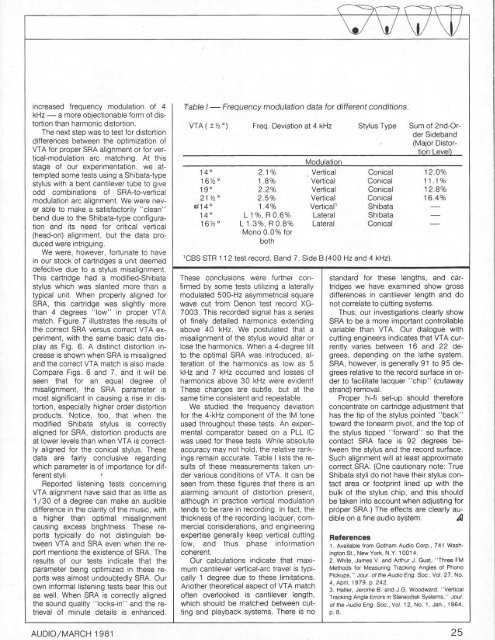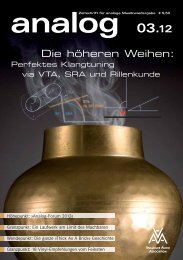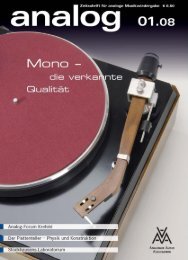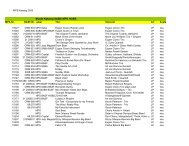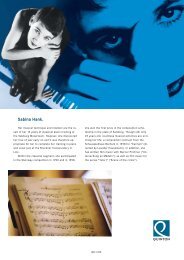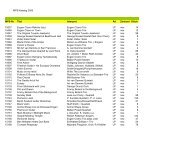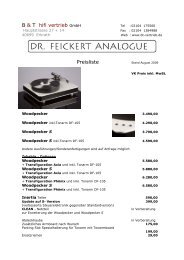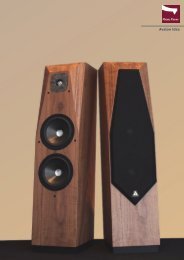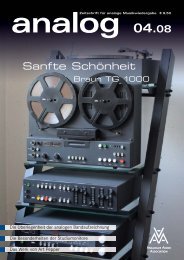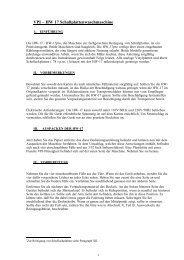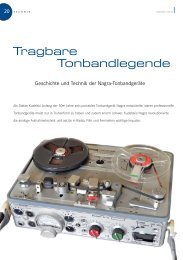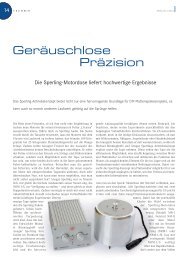Adobe Photoshop PDF
Adobe Photoshop PDF
Adobe Photoshop PDF
You also want an ePaper? Increase the reach of your titles
YUMPU automatically turns print PDFs into web optimized ePapers that Google loves.
increased frequency modulation of 4<br />
kHz - a more objectionable form of distortion<br />
than harmonic distortion.<br />
The next step was to test for distortion<br />
differences between the optimization at<br />
VTA for proper SRA alignment or for vertical-modulation<br />
arc matching. At this<br />
stage of our experimentation, we attempted<br />
some tests using a Shibata-type<br />
stylus with a bent cantilever tube to give<br />
odd combinations of SRA-to-vertical<br />
modulation arc alignment. We were never<br />
able to make a satisfactorily "clean"<br />
bend due to the Shibata-type configuration<br />
and its need for critical vertical<br />
(head-on) alignment, but the data produced<br />
were intriguing.<br />
We were, however, fortunate 10 have<br />
in our stock of cartridges a unit deemed<br />
defective due to a stylus misalignment.<br />
This cartridge had a modified-Shibata<br />
stylus which was slanted more than a<br />
typical unit. When properly aligned for<br />
SRA, this cartridge was slightly more<br />
than 4 degrees "low" in proper VTA<br />
match. Figure 7 illustrates the results of<br />
the correct SRA versus correct VTA experiment,<br />
with the same basic data displayas<br />
Fig, 6. A distinct distortion increase<br />
is shown when SRA is misaligned<br />
ana the correct VTA match is also made.<br />
Compare Figs. 6 and 7, and it will be<br />
seen that for an equal degree of<br />
misatignment, the SRA parameter is<br />
most significant in causing a rise in distortion,<br />
especially higher order distortion<br />
products. Notice, too, that when the<br />
modified Shibata stylus is correctly<br />
aligned for SRA, distortion products are<br />
at lower levels than when VTA is correctly<br />
aligned for the conical stylus. These<br />
data are fairly conclusive regarding<br />
which parameter is of importance for different<br />
styli. •<br />
Reported listening tests concerning<br />
VTA alignment have said that as little as<br />
1/30 of a degree can make an audible<br />
difference in the clarity of the music, with<br />
a higher than optimal misalignment<br />
causing excess brightness. These reports<br />
typically do not distinguish between<br />
VTA and SRA even when the report<br />
mentions the existence of SRA. The<br />
results of our tests indicate that the<br />
parameter being optimized in these reports<br />
was almost undoubtedly SRA. Our<br />
own informal listening tests bear this out<br />
as well. When SRA is correctly aligned<br />
the sound quality "locks-in" and the retrieval<br />
of minute details is enhanced.<br />
ICBS STR 1t 2 test record. Band 7. Side B (400 Hz and 4 kHz).<br />
\ (<br />
V \J \t! \1I<br />
Table I - Frequency modulation data for different conditions.<br />
14 "<br />
16l-'i°<br />
19"<br />
21 y.! 0<br />
tl14°<br />
14 "<br />
16Y.!°<br />
Freq. Deviation at 4 kHz<br />
21%<br />
1.8%<br />
22%<br />
2.5%<br />
t.4%<br />
L 1%, R 0.6%<br />
L 1.3%, R 0.8%<br />
Mono 0.0% for<br />
both<br />
These conclusions were further confirmed<br />
by some tests utilizing a laterally<br />
modulated 50Q-Hz asymmetrical square<br />
wave cut from Denon test record XG<br />
7003. This recorded signal has a series<br />
of finely detailed harmonics extending<br />
above 40 kHz. We postulated that a<br />
misalignment of the stylus would alter or<br />
lose the harmonics. When a 4-degree tilt<br />
to the optimal SRA was introduced, alteration<br />
of the harmonics as low as 5<br />
kHz and 7 kHz occurred and tosses of<br />
harmonics above 30 kHz were evidentl<br />
These changes are subtle, but at the<br />
same time consistent and repeatable.<br />
We studied the frequency deviation<br />
for the 4-kHz component of the 1M tone<br />
used throughout these tests, An experimental<br />
comparator based on a PLL IC<br />
was used for these tests, While absolute<br />
accuracy may not hold, the relative rankings<br />
remain accurate. Table I lists the results<br />
of these measurements taken under<br />
various conditions of VTA. It can be<br />
seen from these figures that there is an<br />
alarming amount of distortion present,<br />
although in practice vertical modulation<br />
tends to be rare in recording. In fact, the<br />
thickness of the recording lacquer, commercial<br />
considerations, and engineering<br />
expertise generally keep vertical cutting<br />
low, and thus phase information<br />
coherent<br />
Our calculations indicate that maximum<br />
cantilever vertical-arc travel is typically<br />
1 degree due to these limitations.<br />
Another theoretical aspect of VTA match<br />
often overlooked is cantilever length,<br />
which should be matched between cutting<br />
and playback systems. There is no<br />
Modulation<br />
Vertical<br />
Vertical<br />
Vertical<br />
Vertical<br />
VerticaP<br />
Lateral<br />
Lateral<br />
Stylus Type Sum of 2nd-Order<br />
Sideband<br />
- (Maior Distortion<br />
Level)<br />
Conical<br />
Conical<br />
Conical<br />
Conical<br />
Shibata<br />
Shibata<br />
Conical<br />
12.0%<br />
t 1.1%<br />
12.8%<br />
t6.4%<br />
standard for these lengths, and cartridges<br />
we have examined show gross<br />
differences in cantilever length and do<br />
not correlate to cutting systems.<br />
Thus, our investigations clearly show<br />
SRA to be a more important controllable<br />
variable than VTA. Our dialogue with<br />
cutting engineers indicates that VTA currently<br />
varies between 16 and 22 degrees,<br />
depending on the lathe system.<br />
SRA, however, is generally 91 to 95 degrees<br />
relative to the record surface in order<br />
to facilitate lacquer "chip" (cutaway<br />
strand) removal.<br />
Proper hi-fi set-up should therefore<br />
concentrate on cartridge adjustment that<br />
has the tip of the stylus pointed "back"<br />
toward the tonearm pivot, and the top of<br />
the stylus tipped "forward" so that the<br />
contact SRA face is 92 degrees between<br />
the styl.us and the record surface.<br />
Such alignment will at least approximate<br />
correct SRA. (One cautionary note: True<br />
Shibata styli do not have their stylus contact<br />
area or footprint lined up with the<br />
bulk of the stylus chip, and this should<br />
be taken into account when adjusting for<br />
proper SRA.) The effects are clearly audible<br />
on a fine audio system. AI<br />
References<br />
1. Available from Gorham Audio Corp., 741 Washington<br />
51., New YoriI, N.Y. 10014.<br />
2. White, James V. and Arthur J. Gusr, "Three FM<br />
Methods fOf Measuring Tracking Angles ot Phono<br />
Pickups." jour, ollhe Audio Eng. Soc" Vol. 27. No.<br />
4, April. 1979. p, 242.<br />
3. Halter, Jefome B. and J.G. Woodward. "Vertical<br />
Tracking Angle Errors in Srereodlsk Systems, ,. Joor.<br />
01 the Audio Eng. Soc., Vol. 12, No.1, Jan.. 1964,<br />
p.8.<br />
AUDIO/MARCH 1981 25


